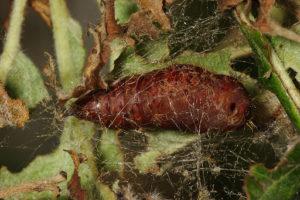The voracious gypsy moth caterpillar and how to deal with it
The most dangerous pest for plants can be called the gypsy moth. This insect causes a lot of damage in agriculture and forestry.
Content
What does a gypsy moth look like (photo)
Description
Name: Unpaired Silkworm
Latin:Lymantria disparClass: Insects - Insecta
Squad: Lepidoptera - Lepidoptera
Family: Erebids - Erebidae
 | Habitats: | forests and gardens |
 | Dangerous for: | oak, linden, coniferous, larch |
 | Means of destruction: | collecting, attracting birds, chemistry |
Some scientists believe that the name was influenced by an unpaired number of warts (blue - 6 pairs, red - 5 pairs). Female and male individuals have a different size, shape of wings and color.
silkworm caterpillar
The larvae are 5 - 7 cm in size. The color is gray - brown. Dorsum with three narrow longitudinal yellow stripes. There are 2 longitudinal black spots on the head.
The warts of an adult caterpillar are blue and bright burgundy with sharp and hard hairs. Getting on the human body, cause irritation and itching.
History of the pest
The gypsy moth appeared at the end of 1860 on the continent. The French naturalist wanted to cross domesticated silkworm, which produces silk, with an unpaired appearance. His goal was to find disease resistance. However, this did not work out.
Having released a few moths, they quickly bred and began to inhabit all the surrounding forests. Thus, insects settled on the entire American continent.
Caterpillars are able to overcome forests, fields, roads. Even eggs on the wheels of carts and cars can travel. Insects populate more and more new countries.
Types of gypsy moth
There are such varieties:
- annular - miniature, the wings of females are 4 cm in size, males - 3 cm. The caterpillar reaches 5,5 cm. It has a gray - blue color. They inhabit Europe and Asia;
- marching - caterpillars migrate to new places of eating. The leader of a long chain starts up a silk thread and all the rest follow him;
- pine cocoonworm - an inhabitant of the coniferous forest of Europe and Siberia. The female is grey-brown. Size 8,5 cm. Male - 6 cm. It damages pine very much;
- Siberian - dangerous for spruce, pine, cedar, fir. Color can be black, gray, brown.
Stages of development
The egg is smooth and round with a pinkish or yellowish color. By autumn, the larva develops and hibernates in the egg shell.
In the spring the larva is released. Her body has numerous long black hairs. With their help, the wind carries over long distances.
The pupation period falls in mid-summer. The pupa is dark brown with a tuft of short red hairs. This stage lasts for 10-15 days.
Egg laying occurs in the form of heaps in the bark, on branches and trunks. The ovipositor is similar to a soft and fluffy rounded pad. Mass reproduction of the insect has the appearance of yellow plaques. They can cover the entire underside of horizontal branches. Also, such places can be stones, walls of buildings, containers, vehicles.
Pest diet
Insects are very unpretentious in nutrition. They can consume about 300 varieties of trees.
They feed on the leaves of such trees.As:
- birch;
- oak;
- Apple tree;
- plum;
- Linden.
Caterpillars do not feed on:
- ash;
- elm;
- Robinia;
- field maple;
- honeysuckle.
The larvae feed on small shrubs and conifers. They differ in particular gluttony. But vitality and fertility are most of all given to the gypsy moth by oak and poplar leaves.
Lifestyle and habitat
Butterfly flight begins in the second half of July. The females lay eggs and cover the eggs with hairs. The females live for several weeks. However, about 1000 eggs are laid during this period.
They have a wide range. On the European continent they live up to the borders of Scandinavia. In Asian countries live in:
- Israel;
- Turkey;
- Afghanistan;
- Japan
- China;
- Korea.
Pest Elimination Methods
To prevent pests from destroying plants, they must be fought. For this you can apply:
- collection by hand. Scraping and destroying ovipositors;
- insecticide treatment when larvae appear en masse;
- installation of a sticky hunting belt on a trunk;
- insectivorous birds;
- pheromone traps.
Tips from an experienced gardener on dealing with caterpillars help destroy the pest.
Conclusion
Gypsy moth very quickly settles in new places. Mass reproduction threatens the destruction of plants. In this regard, pest control is carried out on the plots.
Previous